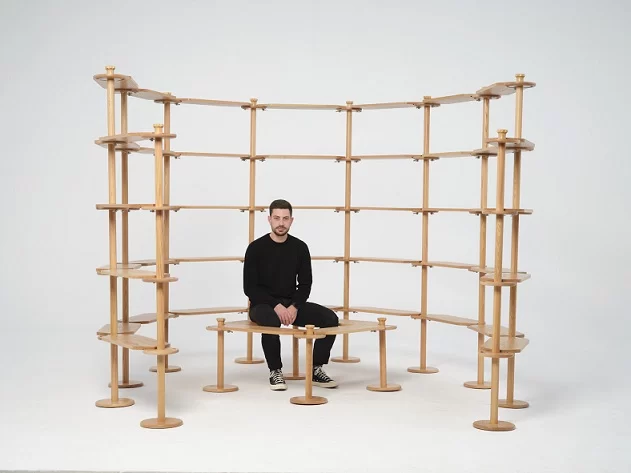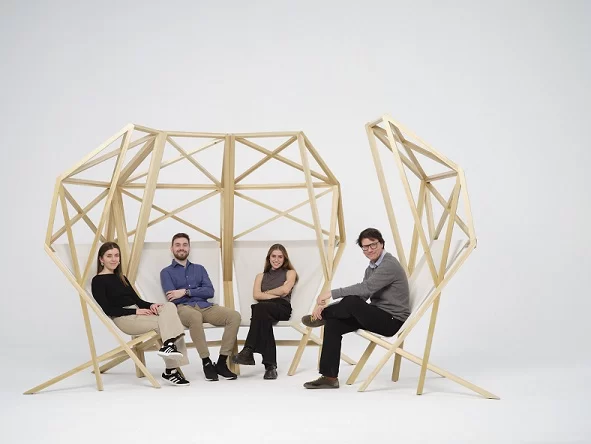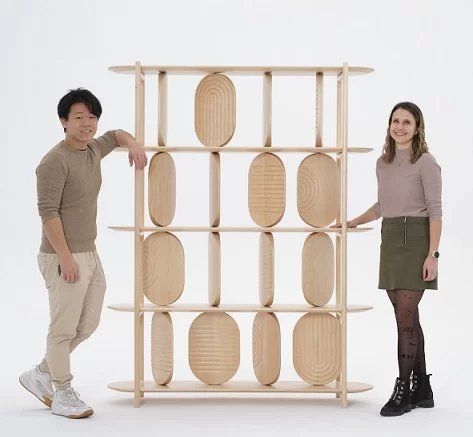
The American Hardwood Export Council (AHEC) has unveiled SLOW Spain: Slow furniture for fast change at the Madrid Design Festival 2023, which opened on February 7, 2023. Bringing together the work of 17 students selected from 9 Spanish design schools, SLOW Spain: Slow design for fast change showcases the talent and ideas of the emerging design generation while exploring the material possibilities of four sustainable but underused American hardwoods. From one or more of four hardwoods – American red oak, cherry, and hard and soft maple – each designer has created an object that reflects their approach towards the theme ‘slow design for fast change’. The collection was on display from February 7 to March 12, 2023, at the Fernán Gómez Centro Cultural de la Villa, as part of the official programming of the Madrid Design Festival 2023.
The projects, all focused on furniture design, have been mentored by renowned designers Inma Bermúdez and Moritz Krefter (Studio Inma Bermúdez), Álvaro Catalán de Ocón (ACdO) and Jorge Penadés (Oficina Penadés). Together with the students, they have worked to refine and shape their ideas using a selection of sustainable American hardwoods. The exhibition aims to show the importance of ‘slow design’ and how this philosophy can be applied in the creation of furniture. Each of the pieces has been handcrafted in the La Navarra carpentry in Madrid, from a selection of four sustainable American hardwoods that are underused in Europe: red oak, maple, cherry and tulipwood. The final designs mix aesthetics with functionality, and range from side tables to a bookcase-screen, a desk or the reinvention of a chair.

Highlighting the importance of promoting design among young students, David Venables, AHEC’s European Director, said: “SLOW is about education and opportunity. We have attempted to fill the gap in design education which often does not provide an in-depth experience for design students to learn about and work with hardwood materials. By engaging some of the leading design schools in Spain we have educated hundreds of potential designers about American hardwoods and given a unique opportunity for nine chosen design teams to realize their vision and work with experienced design mentors, and the acclaimed carpentry company La Navarra. The result is an eclectic mix of cleverly designed and beautifully made solutions that we hope will help launch these designers’ careers and show how these valuable hardwood materials can contribute to a more sustainable approach to product design.”
According to AHEC, SLOW Spain: Slow furniture for fast change, is a unique opportunity to see the work of the most promising young Spanish designers and how they have approached the concept of ‘slow design’ in their projects. As well as being an opportunity to learn more about the importance of sustainability in furniture design, the ‘slow’ approach to design can contribute to a positive change in our current culture, creating an emotional bond with the owner of the pieces and leaving a legacy for future generations. The collaboration builds on previous AHEC initiatives such as Legacy (2019), Connected (2020) and Discovered (2021). These exhibitions brought together the work of multiple designers, whose projects were developed from imaginative briefs that prioritized the beauty, durability and sustainability of American hardwoods.
This Spanish edition is the second of AHEC’s SLOW projects. The first, in 2021, brought together students and ideas from the best design schools in Germany at the Kunstgewerbemuseum (Museum of Decorative Arts) in Berlin, where it received widespread attention from the public and from the press. Now SLOW comes to Spain, bringing Madrid a platform where the next generation of Spanish designers can present their own slow designs for the future. The designers involved with the project are Jonathan Paige, Berta Albiac Adell, Queralt Font Sabadell, Albert Roca Nonell, Cèlia Anglés, Arnau Anoro, Sheila Valle García, Alejandro Lorca, Elena Romero, Cristina Urbano, Eli Yang, Anna Perathoner, Daniela González Martínez, Natale Armendáriz, Jon Calleja, Nora Etxeberria, and Ane Ozkoidi.

A carbon footprint of the nine designs has been prepared to provide insights into the environmental impacts of the individual designs at each stage of the product life cycle. According to the report, at the point of delivery to the exhibition in Madrid, the total GWP or ‘carbon footprint’ of all nine of the SLOW Spain designs is 712 kg of CO2 equivalent (kg CO2e). That’s equal to the carbon emissions of driving 6,600 kilometers in an average Spanish car, or, to put another way, about the same as emitted by the average Spaniard over a one month period. A large proportion of emissions associated with the designs is offset by carbon stored in the sustainable wood materials which constitute nearly nine tenths of their total weight. The emphasis on ‘slow’ design to create durable timeless pieces means that this carbon is likely to remain stored in the furniture for many years. It also reduces the frequency of replication of environmental impacts due to product replacement.
The American hardwood lumber delivered to La Navarra carpentry represents a significant store of carbon. The carbon stored in the wood during growth (1,111 kg CO2e) exceeded all carbon emissions during material extraction and processing and transport from the U.S. (kg CO2e). Of these emissions, those during processing (89% – mostly kiln drying) greatly exceeded those during transport (11%) despite the shipping distance involved. Significantly, only around 4% of carbon emissions to deliver the American lumber to the workshop in Madrid occurred during forestry operations. The foundation of any claim about the carbon benefits of wood products depends on their being from a sustainable source. The LCA of US hardwood undertaken by PE International (now Sphera) proves that American maple, red oak, tulipwood, and cherry are all abundant and sustainably harvested timber species, coming from naturally re-grown forests.
“U.S. government forest inventory data shows that every year, after natural mortality and harvesting are accounted for, the volume of maple, red oak, tulipwood and cherry in U.S. forests increases respectively by 29.2 million m3, 28.7 million m3, 21.8 million m3 and 5.4 million m3. It takes just over 2 seconds for the hardwood harvested to manufacture all nine of the designs to be replaced by new growth in the U.S. forest. Given that maple, red oak, tulipwood, and cherry are all underutilized from a forestry perspective, this project aims to create a larger market for these timbers and reduce pressure on other less abundant commercial hardwood species. Slow design is fast becoming an economic mindset. In this context, wood is becoming increasingly preferable as a design material, thanks to its natural look and texture and to its inherent sustainability – the perfect choice for ‘slow’ design,” concluded Roderick Wiles, AHEC Regional Director.

Daisy by Jonathan Paige
American red oak
With his spare time spent painting and parenting, Jonathan wanted to design a piece of furniture that was aesthetically pleasing, multi-functional and a calm space to take time for creativity and family. The elegant desk has two lids, each opening in a different direction, which transforms the piece into two easels with storage space underneath, and a cleverly hidden easel tray in the drawer handle. Dovetail joints hold together the drawer sides, and the curved edges are achieved through thin layers of veneer. Jonathan chose American red oak for its color, which can vary from light reddish brown to a pale biscuit, and its vibrant grain texture.
Pami by Berta Albiac Adell, Queralt Font Sabadell, Albert Roca Nonell
American maple
A desire for an object that could bring a sense of warmth and tranquility to a space started the design process for the designers of Pami. Secondly, a versatile piece was essential. As well as a beautiful object in itself, the piece also functions as a table, storage and lighting. Its size and shape make it compact and portable so it can be placed in different spaces around the home. Each level is connected with a brass inset that supplies ambient LED lighting through the piece. The team selected American maple for its lighter, almost translucent tones, and its hardness that adds stability to the finished object.
Leve Mon Verre by Cèlia Anglés
American maple, red oak, cherry and tulipwood
ESDAP Campus Llotja – Escola Superior Disseny i d’Arts Plàstiques de Catalunya Inspired by cherished moments connecting with friends and family sharing wine, Cèlia wanted to create an object that would become a centerpiece to these times. Leve Mon Verre is a playful drinks cabinet that invites people to come together to share a drink. Cèlia selected American maple, red oak, cherry and tulipwood for their contrasting tones and textures creating a cabinet full of character that is a conversation starter in its own right.
Scaffold by Arnau Anoro
American red oak
Reflecting on a new way of working and the objects that surround us in our homes, Arnau identified that the furniture we choose must now serve a dual purpose; a space for focus and a space for relaxation. Through his research, he was drawn to the adaptability and standardized form of construction scaffolding. The aptly titled piece Scaffold is a shelving system that grows or shrinks with its home whilst creating new spaces for storage. American red oak was chosen for its strength and stiffness, essential for the shelving to be moved around safely, and because it is relatively easy to machine.
Blas by Sheila Valle García
American tulipwood
After observing the Logroño food market – a space that used to foster a sense of community, but in recent years has become modernized and fast-paced – Sheila wanted to design a piece that could reintroduce older traditions for all generations of people who inhabit the market. The final design takes cues from the classic Enea and Misericord chairs; a type of church seating that doubles as a shelf to support a person in a partially standing position during long periods of prayer. For the main structure, Sheila chose American tulipwood because of the sinuosity of its veins and tonal variation and Danish cord has been woven to create a comfortable back support.
TÖEI by Alejandro Lorca, Elena Romero, Cristina Urbano
American tulipwood
The designers of TÖEI wanted to create a space for rest and escapism, which led to them an architectural shape that forms a cocoon around whoever is sitting inside. Its structure is formed by slats of timber that are precisely dovetailed together at a 45 degree angle to give the chair strength and durability. American tulipwood was the timber of choice. Because of its overall strength properties relative to its weight, tulipwood lends itself well to the lightweight design of the chair. Varying tones between the heartwood and sapwood adds character to the piece.
Todo Toca by Eli Yang, Anna Perathoner
American maple
Every home is unique to its occupant, and each carries its own special memories. The designers of Todo Toca wanted to create a piece that would capture this and become more than just a shelf, but a place of reflection and remembrance. Each panel is carved with different patterns, inviting users to touch and feel the wood. The panels also spin, giving many different configurations that will change and grow over time as the shelf is filled with keepsakes. The designers chose American maple for its light and bright tones and its toughness.
Bondu by Daniela González Martínez
American cherry
Daniela wanted her piece to celebrate the beauty of the timber in its natural state. She took cues from Japanese craftsmanship, which observes the qualities of wood and takes advantage of all its unpredictability and inconsistency, and from the Chidori joint; traditional Japanese joinery where wood planks are connected through a system allowing them to stay together even without the use of nails or glue. American cherry was chosen for its excellent finishing qualities and the inherent warmth it can bring to any space.
Habi by Natale Armendáriz, Jon Calleja, Nora Etxeberria, Ane Ozkoidi
American maple
What happens to a crib once it is outgrown? In most cases, it will be disposed of or left to gather dust. The designers of Habi approached their project by reconsidering the possibilities of reuse and other forms the crib could take. Made using demountable parts and woven fabric, the piece can be quickly transformed into a hanging rack and storage once the crib is no longer needed. The team chose American maple for its strength and durability that was essential for the deconstructable joints.
